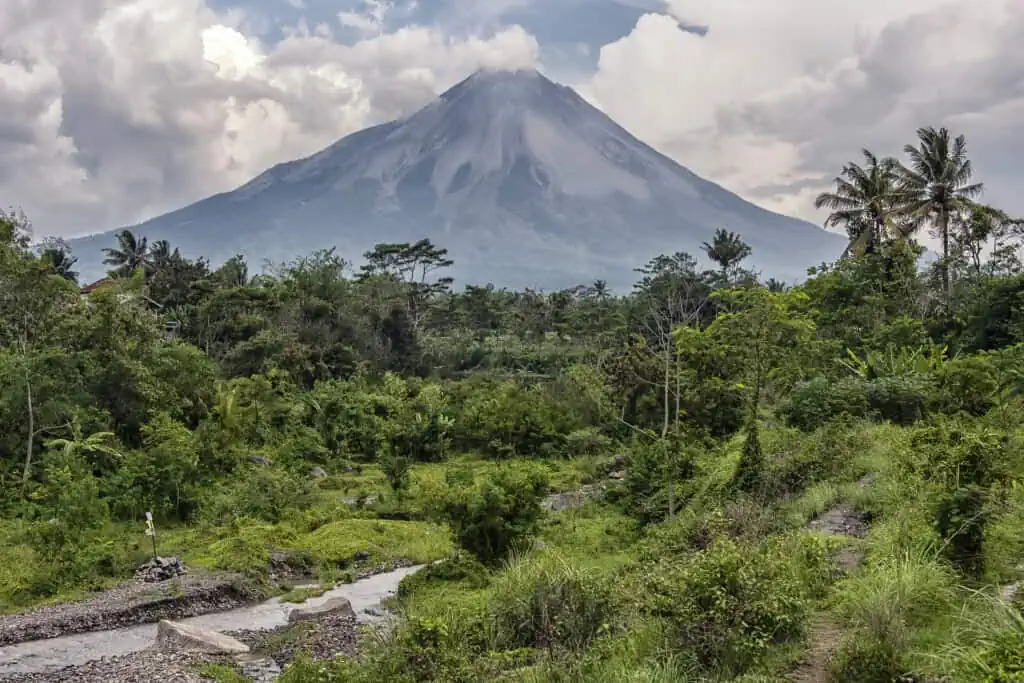
Merapi volcano in Central Java, Indonesia.
Java and Bali are familiar names in the atlas of legend and imagination: Java mainly because of an historical association with coffee so powerful that it lent coffee one of its nicknames, and Bali for reasons that have little to do with coffee, but with the famous beauty of the island and its people and culture. Today, both islands produce coffees of charm and interest, and this month we report on a small but impressive selection.
To say Java has a long history in coffee would be an understatement. After the colonial Dutch established Arabica coffee as a money-making crop on Java around 1700, the island, together with Yemen, supplied all of the coffee consumed in the world for the next 30 years. Thereafter, Java had to share the world coffee stage with a succession of other coffee origins, but retained enough of its original fame to command higher prices than most other coffees mainly on the basis of its name, much like Kona or Jamaica Blue Mountain do today.
But in the late 19th century, coffee leaf rust disease, coffee’s great and continued scourge, wiped out virtually all Arabica coffee in Java. The Dutch responded by moving Arabica production to the mountains of East Java, where higher elevations discouraged leaf rust. There they established what are now called “government estates” dedicated to producing Arabica, and replaced Arabica with rust-resistant Robusta elsewhere on the island. These new large estates in East Java were set up along “modern” lines, meaning the coffee was processed using the latest wet or washed method, in which all of the fruit residue is removed or “washed” from the beans before they are dried, with the goal of achieving purity and consistency.
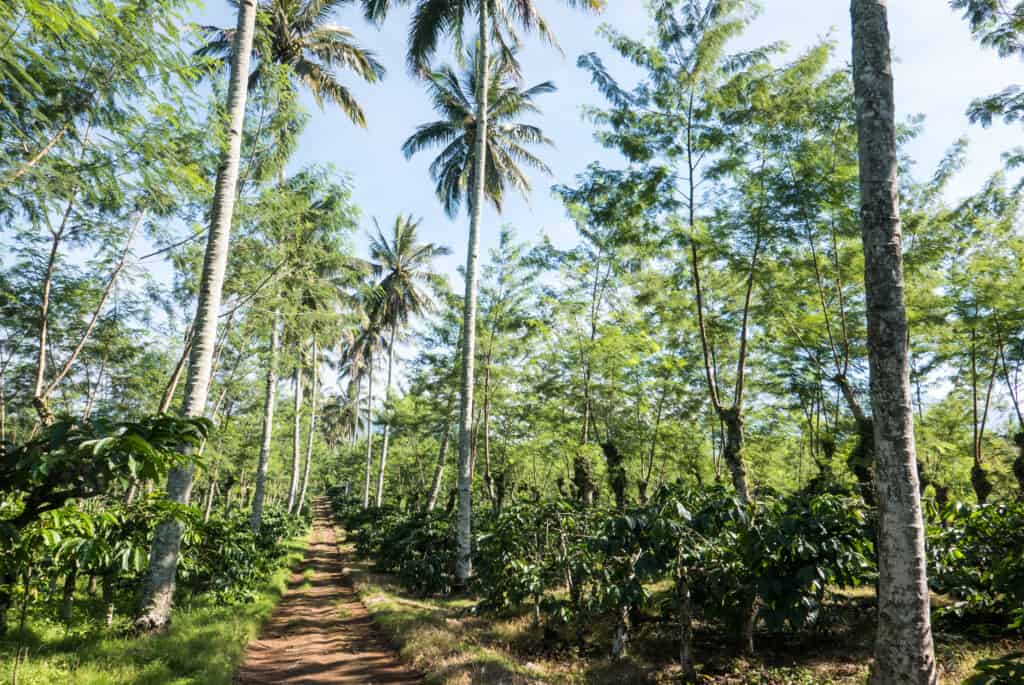
A large coffee estate in East Java.
Sumatra Takes Over
When I first began tasting these government estate Javas in the 1970s, I found a familiar conventionally wet-processed cup, similar to the style produced by many regions of the world then and now: straightforward, satisfying, but absent any striking characteristics that would help consistently differentiate it from any other of the world’s straightforward, satisfying coffees. These coffees were mainly distinguished by the simple fact that they were produced in Java, though certain lots might be more distinctive (mild spice tones usually) than others. Early in the specialty movement (1970s through 1990s), these large-estate Javas continued to appear with some prominence on specialty coffee menus. But given the tendency for specialty coffee consumers to look for coffees that tasted recognizably new and different, these large-estate Javas, with their mild, clean, yet unremarkable profiles, started to disappear from offering lists of the specialty coffee movement. What replaced them?
Coffees from Sumatra, the larger Indonesian island stretching west of Java. First popularized by Alfred Peet, Sumatras offered two appeals to the newly emerging specialty coffee movement that Javas did not. First, because the fruit was removed using a uniquely Indonesian system that we now call “wet-hulling,” Sumatra coffees tended to taste different from many other of the world’s coffees. They displayed their now celebrated “earthy” character (a mild mustiness that can suggest pleasant sensations like pipe tobacco or freshly turned humus), and they were strong-charactered and hearty enough to stand up to the then-fashionable dark roasting, which applied right to the right Sumatras turned the “earth” toward chocolate.
By comparison, the mild, proper government-estate Javas probably struck specialty dark-roast drinkers as a bit tame. Gradually Java disappeared as a go-to origin, and by around 2000 was close to disappearing entirely from North American specialty coffee menus.
So Why a Java Report?
Nevertheless, we decided to put Java on our report schedule this year because word was out among specialty coffee insiders that smallholding and startup growers on Java were beginning to produce a new generation of interesting, distinctive coffees that did not resemble the predictable East Java washed estate style of past decades.
True, we apparently were a bit premature in our sampling, as we were able to source only six Java-grown coffees. On the other hand, five of those six were from smaller producers, and all five were interesting, engaging coffees, suggesting that the importer-roaster community might want to pay a bit more attention to this new direction from an old origin. The six Javas we tested averaged a rating of 91, with a low of 84 and a high of 94. But if we exclude the one 84-rated anonymous Java, producer unnamed, the remaining five averaged a very impressive 92.6.
The freshness of approach among these five new-wave Java coffees was particularly reflected in the range of processing methods. Two of the five were processed using the traditional Indonesian wet-hulled method, two by variations on the natural method (dried in the whole fruit), and one by the conventional washed method.
Wet-Hulling, Earth Notes and Javas
In the wet-hulled method, the soft fruit residue is removed as it is in the traditional washed or wet method: by removing the skins from the fruit, loosening the sticky fruit flesh through fermentation, then washing the loosened flesh off the beans. However, in the wet-hulling variation of the washed method, the remaining moist, inner parchment skin, which is usually left on the beans until they are dried, is removed in the middle of the drying process, when the beans still retain somewhere between 20 percent and 40 percent moisture. The beans are dried the rest of the way, to 12 percent or 13 percent, after parchment removal. The result is a mild, fortuitous mustiness that, if everything goes well, lends the best wet-hulled coffees their unusual depth of sensation and their complex, fruit-twisting earth notes. This method is most famously associated with Sumatra, but is practiced almost everywhere in Indonesia where coffees are processed by smallholding farmers.
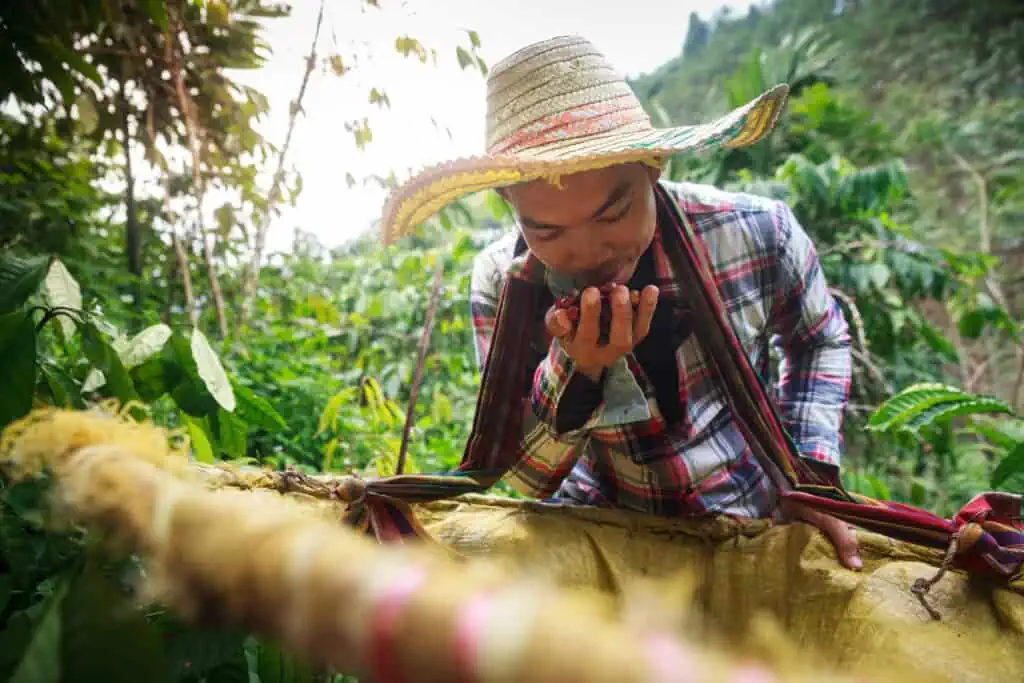
Java small-holding producer with freshly picked coffee.
With the top-rated Peach Coffee Blue Sunda Estate Java (94), earth hints simply contribute depth to the complex spice, chocolate and cedar of this intricate, original yet balanced wet-hulled coffee. The impact of wet-hulling is much more explicit in the Small Eyes Indonesia Java Sunda Supreme SC18 (92), with its sweet tobacco, oak and musky lily notes.
Among the other Javas we review, the Corvus Coffee Java Frinsa Estate Natural (93) shows some of the fruit-forward character popularly associated with dried-in-the-fruit or natural-processed coffees, but here manifested in a surprisingly brisk, tangy-bright character. The Equator Coffees Java Argopuro Mountain Anaerobic Natural (93) demonstrates how new Java producers are aware of the latest global trends in experimental processing. The Argopuro Mountain is fermented in the whole fruit in sealed tanks before drying, with the constrained exposure to oxygen during fermentation contributing a background lactic tang to the profile and intensifying both sweetness and complexity. Look for a fusion of pineapple and cocoa carrying from nose to finish in this fine, balanced anaerobic coffee.
Bali: Grace and Variety
The relatively small island of Bali, rising off the western tip of Java, shares little of Java’s long coffee history, though the Balinese people are well aware and proud of the “kopi Bali” they serve to the luckier among the many tourists who visit their amazing island every year.
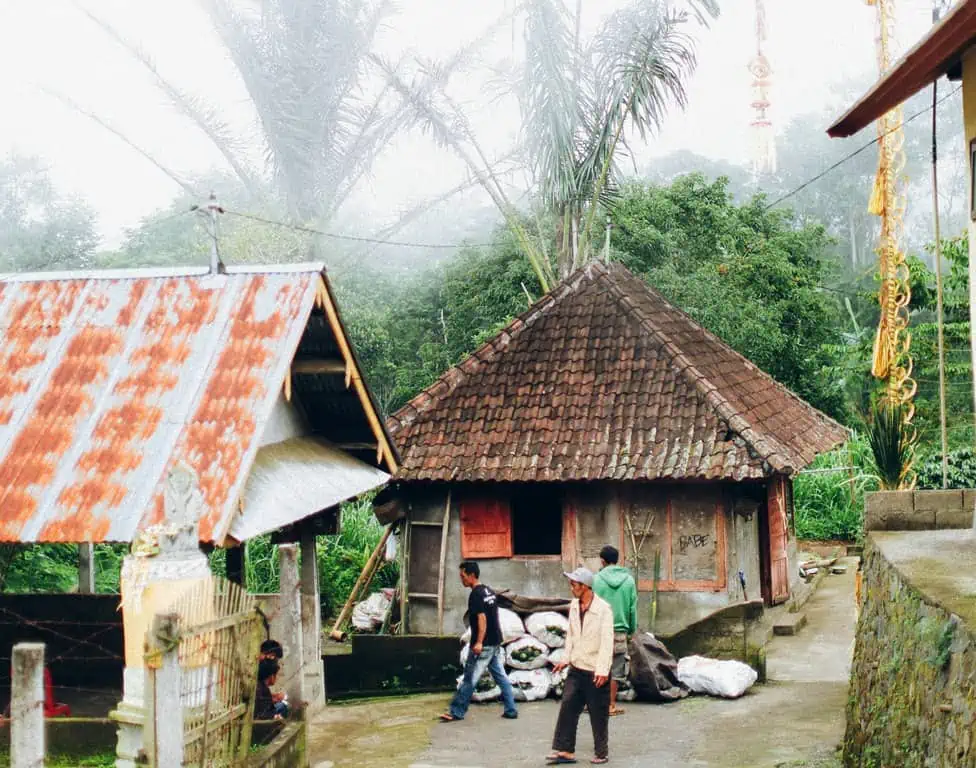
Coffee-growing village, Kintamani highlands, Bali. Courtesy of Noble Coffee Roasting.
We had as much difficulty turning up Bali coffees as we did with Javas, ending with a similar total of only six samples. They averaged a solid rating of 89, however, with a low of 81 and a high of 93. Four are reviewed here.
The compact Bali growing region, situated in the central Kintamani highlands of the island, now produces mainly natural-processed coffee, along with some wet-hulled and selections processed by more experimental methods. The practice of natural processing, or drying coffee in the whole fruit, apparently was first suggested to Balinese farmers a couple of decades ago by the California arm of importer Royal Coffee as a water-saving alternative to the usual Indonesian wet-hulled method.
We review two Bali naturals. The Bassline Coffee Bali Kintamani (93) is an impressive rendition of the lusher style of natural, in this case deep, brandy- and chocolate-toned, with a particularly fine floral sweetness. The Succulent Coffee Roasters Bali Kintamani (92) leans more toward the savory nut-and-cocoa expression of the style, here enlivened by a tart-sweet raspberry.
Noble Coffee Roasting’s Kintamani Bali (92) is processed by the traditional Indonesian wet-hulled method, and expresses the genius of wet-hulling with unusual delicacy: No earth notes here; instead, sweet pipe tobacco, cedar and date. Those who enjoy traditional Sumatras but find them a bit too blunt may enjoy this graceful Balinese rendering of the style.
Finally, Taiwanese roaster Kopi Ibrik offers a “yeast-honey” processed Bali (91). Kopi Ibrik is a roastery-café in the intimate tradition of Taiwanese neighborhood coffee places. Owner Guangyou Zhang does his best to combine Turkish inspiration and Turkish-style brewing with contemporary specialty coffee practices. Apparently, his Bali was fermented with the addition of cultured yeasts before it was dried with skin and pulp removed, but with the fruit flesh or mucilage (the “honey”) still coating the beans. In the cup, peach and caramel sweetness overlap deep savory notes that our tasters associated with shiitake mushroom. Despite the forcefulness of the shiitake side of the profile, this is a very delicate coffee overall, with additional teasing hints of flowers.
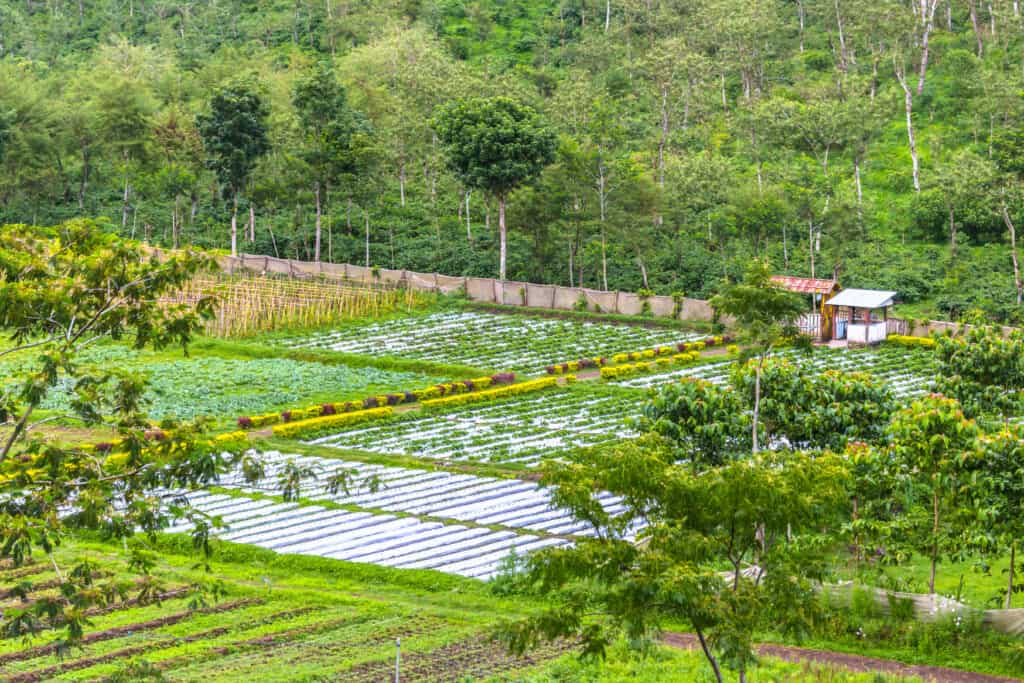
Coffee grows beneath the shade trees along the top of this photo, overlooking other crops in the intensely but reverently cultivated landscape of Bali.
Spiritual Coffee: Subak Abian
Subak, the traditional irrigation system in Bali, was developed in the 9th century. A subak not only manages water for member farms, but is a community-based system that supports a sustainable relationship with nature and among those who belong to the subak. Subaks are premised on Tri Hita Karana—a Hindu principle aimed at maintaining harmony among humans, nature and god. A subak yeh is related to rice farming, while a subak abian is traditionally associated with dry land crops like coffee. It appears that most coffees from the Kintamani highlands are produced by subak abians.
Enjoy These and Look for More
However limited our sampling, the eight Java and Bali coffees reviewed here suggest the wide-ranging possibilities and pleasures offered by these two origins today, as new processing methods join the local wet-hulled tradition to generate an exciting, globalizing menu of coffee possibility.
Thanks to those who enriched this report by sharing ideas and information regarding Java or Bali coffees: Phil Goodlaxson, Corvus Coffee Roasters; Tim Hester, Bassline Coffee; Adam Monaghan, Succulent Coffee Roasters; Josh Puckett, Peach Coffee Roasters; Jared Rennie, Noble Coffee Roasting; Ted Stachura, Equator Coffees; Tom from Small Eyes Café; Guangyou Zhang, Kopi Ibrik.

